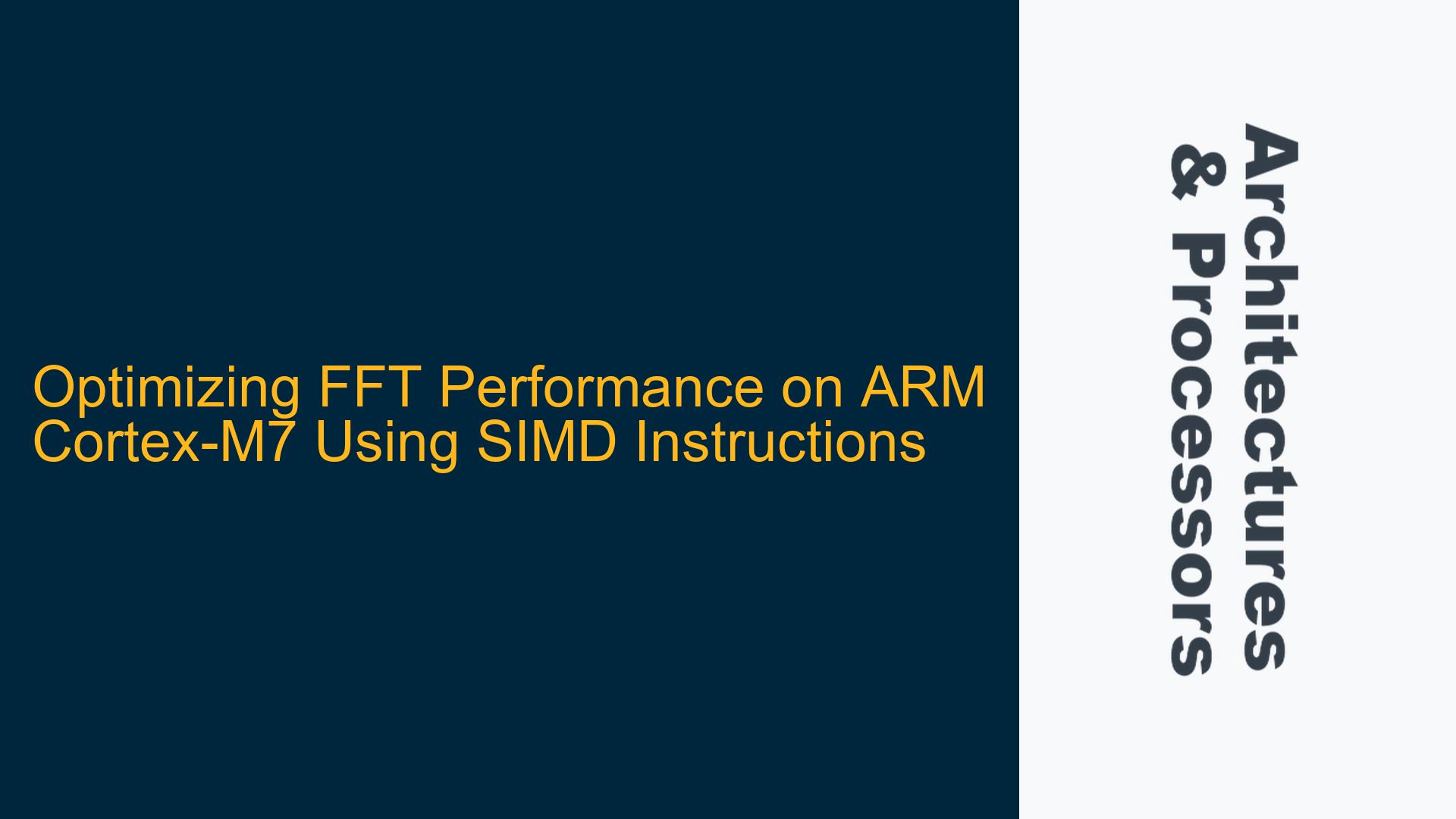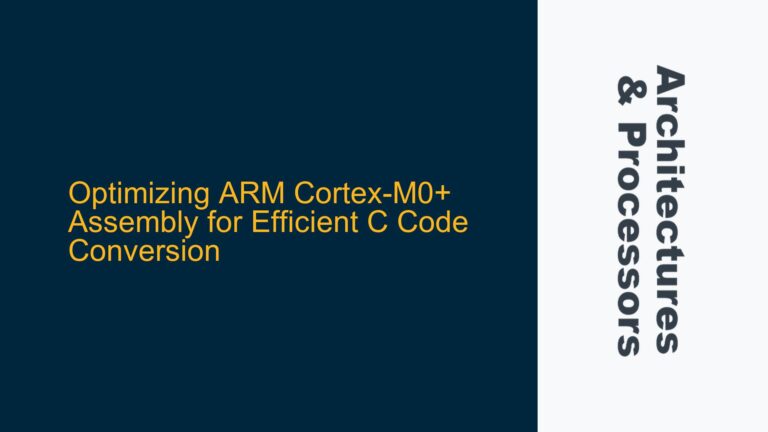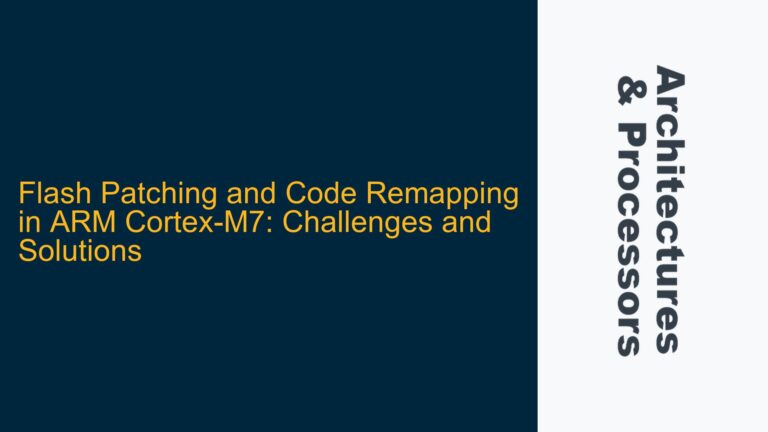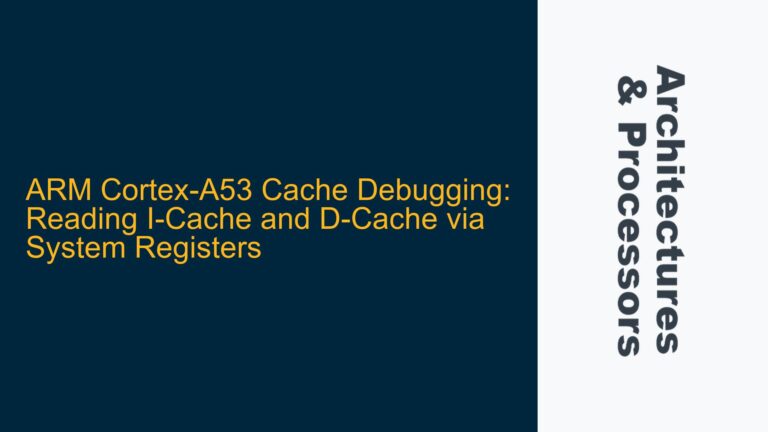ARM Cortex-M7 FFT Performance Challenges with SIMD Utilization
The ARM Cortex-M7 processor, known for its high performance in embedded applications, is often utilized for digital signal processing (DSP) tasks such as the Fast Fourier Transform (FFT). The Cortex-M7’s Single Instruction Multiple Data (SIMD) capabilities, particularly through its DSP extension instructions, offer significant potential for accelerating FFT computations. However, achieving optimal performance with SIMD on the Cortex-M7 requires a deep understanding of both the processor’s architecture and the FFT algorithm’s computational demands.
The Cortex-M7’s SIMD instructions, such as those in the ARMv7E-M architecture, allow for parallel processing of multiple data points within a single instruction cycle. This parallelism is crucial for FFT computations, which involve repetitive complex arithmetic operations on large datasets. However, the Cortex-M7’s SIMD capabilities are not as extensive as those found in higher-end processors like the Cortex-A series, which can lead to suboptimal performance if not carefully managed.
One of the primary challenges in optimizing FFT performance on the Cortex-M7 is the efficient utilization of the processor’s SIMD instructions. The Cortex-M7’s SIMD instructions are designed to operate on 32-bit data, which aligns well with the single-precision floating-point format commonly used in FFT computations. However, the Cortex-M7’s SIMD capabilities are limited to specific operations, such as parallel addition, subtraction, and multiplication, which may not cover all the operations required for an efficient FFT implementation.
Another challenge is the Cortex-M7’s memory subsystem, which can become a bottleneck during FFT computations. The FFT algorithm requires frequent access to large datasets, and the Cortex-M7’s memory bandwidth and latency can limit the overall performance. The Cortex-M7’s cache architecture, including its instruction and data caches, plays a critical role in mitigating these memory access issues. However, improper cache management can lead to cache thrashing, where the cache is repeatedly overwritten, resulting in increased memory access latency and reduced performance.
SIMD Instruction Limitations and Memory Subsystem Bottlenecks
The limitations of the Cortex-M7’s SIMD instructions and the potential bottlenecks in its memory subsystem are the primary factors contributing to suboptimal FFT performance. The Cortex-M7’s SIMD instructions are designed to operate on 32-bit data, which is suitable for single-precision floating-point operations. However, the Cortex-M7’s SIMD capabilities are limited to specific arithmetic operations, such as parallel addition, subtraction, and multiplication. This limitation can restrict the efficiency of FFT implementations, which often require more complex operations such as bit-reversal, twiddle factor multiplication, and complex number arithmetic.
The Cortex-M7’s memory subsystem can also become a bottleneck during FFT computations. The FFT algorithm requires frequent access to large datasets, and the Cortex-M7’s memory bandwidth and latency can limit the overall performance. The Cortex-M7’s cache architecture, including its instruction and data caches, plays a critical role in mitigating these memory access issues. However, improper cache management can lead to cache thrashing, where the cache is repeatedly overwritten, resulting in increased memory access latency and reduced performance.
The Cortex-M7’s memory subsystem includes a Harvard architecture, which separates the instruction and data buses, allowing for simultaneous access to instruction and data memory. This architecture can improve performance by reducing contention for memory access. However, the Cortex-M7’s memory subsystem also includes a Memory Protection Unit (MPU), which can introduce additional latency if not properly configured. The MPU is used to enforce memory access permissions and can cause exceptions if an access violation occurs, leading to increased latency and reduced performance.
The Cortex-M7’s cache architecture includes both instruction and data caches, which can significantly improve performance by reducing memory access latency. However, the cache architecture can also introduce challenges, particularly in FFT computations, where the access patterns can be irregular and unpredictable. The Cortex-M7’s cache architecture includes a write-back policy, which can improve performance by reducing the number of write operations to main memory. However, this policy can also lead to cache coherence issues, particularly in multi-core systems or systems with DMA (Direct Memory Access) controllers.
Implementing Efficient FFT Algorithms with Cortex-M7 SIMD and Cache Optimization
To achieve optimal FFT performance on the Cortex-M7, it is essential to implement efficient FFT algorithms that leverage the processor’s SIMD instructions and optimize cache usage. The following steps outline a comprehensive approach to optimizing FFT performance on the Cortex-M7:
1. Leverage Cortex-M7 SIMD Instructions for Parallel Processing:
The Cortex-M7’s SIMD instructions can be used to accelerate FFT computations by performing parallel arithmetic operations on multiple data points. The Cortex-M7’s SIMD instructions include parallel addition, subtraction, and multiplication, which can be used to accelerate the complex arithmetic operations required for FFT computations. For example, the Cortex-M7’s SIMD instructions can be used to perform parallel complex number multiplication, which is a key operation in the FFT algorithm. By leveraging the Cortex-M7’s SIMD instructions, the number of instruction cycles required for FFT computations can be significantly reduced, leading to improved performance.
2. Optimize Memory Access Patterns for Cache Efficiency:
The Cortex-M7’s cache architecture can significantly improve performance by reducing memory access latency. However, the cache architecture can also introduce challenges, particularly in FFT computations, where the access patterns can be irregular and unpredictable. To optimize cache usage, it is essential to align data structures with cache line boundaries and to minimize cache thrashing by ensuring that frequently accessed data remains in the cache. For example, the FFT algorithm’s twiddle factors can be precomputed and stored in a cache-friendly manner to reduce memory access latency. Additionally, the Cortex-M7’s cache architecture includes a write-back policy, which can improve performance by reducing the number of write operations to main memory. However, this policy can also lead to cache coherence issues, particularly in multi-core systems or systems with DMA controllers. To mitigate these issues, it is essential to use cache maintenance operations, such as cache cleaning and invalidation, to ensure cache coherence.
3. Utilize Cortex-M7 DSP Library for Optimized FFT Implementations:
The ARM CMSIS-DSP library provides optimized FFT implementations that leverage the Cortex-M7’s SIMD instructions and cache architecture. The CMSIS-DSP library includes a range of FFT functions, including radix-2, radix-4, and mixed-radix FFTs, which can be used to accelerate FFT computations on the Cortex-M7. The CMSIS-DSP library also includes functions for complex number arithmetic, vector operations, and matrix operations, which can be used to implement custom FFT algorithms. By utilizing the CMSIS-DSP library, developers can achieve optimal FFT performance on the Cortex-M7 without the need for extensive low-level optimization.
4. Profile and Optimize FFT Performance Using Hardware Counters:
The Cortex-M7 includes hardware counters that can be used to profile and optimize FFT performance. The hardware counters can be used to measure key performance metrics, such as instruction cycles, cache hits, and cache misses, which can be used to identify performance bottlenecks. For example, the hardware counters can be used to measure the number of cache misses during FFT computations, which can be used to identify cache thrashing and optimize cache usage. Additionally, the hardware counters can be used to measure the number of instruction cycles required for FFT computations, which can be used to identify inefficient code and optimize SIMD instruction usage. By profiling and optimizing FFT performance using hardware counters, developers can achieve optimal performance on the Cortex-M7.
5. Implement Data Synchronization Barriers for Cache Coherency:
In systems with DMA controllers or multi-core processors, cache coherency can become a significant issue during FFT computations. The Cortex-M7’s cache architecture includes a write-back policy, which can lead to cache coherence issues if not properly managed. To ensure cache coherency, it is essential to implement data synchronization barriers, such as the Data Synchronization Barrier (DSB) and Data Memory Barrier (DMB) instructions. These instructions ensure that all memory operations are completed before proceeding to the next instruction, which can prevent cache coherence issues and improve performance. Additionally, cache maintenance operations, such as cache cleaning and invalidation, can be used to ensure cache coherence in systems with DMA controllers or multi-core processors.
6. Optimize Twiddle Factor Computation and Storage:
The FFT algorithm’s twiddle factors are complex numbers that are used to perform the complex arithmetic operations required for FFT computations. The computation and storage of twiddle factors can significantly impact FFT performance on the Cortex-M7. To optimize twiddle factor computation and storage, it is essential to precompute the twiddle factors and store them in a cache-friendly manner. For example, the twiddle factors can be stored in a lookup table, which can be accessed efficiently using the Cortex-M7’s SIMD instructions. Additionally, the twiddle factors can be computed on-the-fly using the Cortex-M7’s SIMD instructions, which can reduce memory access latency and improve performance.
7. Minimize Branch Mispredictions and Pipeline Stalls:
The Cortex-M7’s pipeline architecture can introduce performance bottlenecks if not properly managed. Branch mispredictions and pipeline stalls can significantly impact FFT performance on the Cortex-M7. To minimize branch mispredictions and pipeline stalls, it is essential to use branch prediction techniques, such as loop unrolling and inline functions, which can reduce the number of branch instructions and improve pipeline efficiency. Additionally, the Cortex-M7’s SIMD instructions can be used to reduce the number of instruction cycles required for FFT computations, which can minimize pipeline stalls and improve performance.
8. Utilize Cortex-M7 Floating-Point Unit (FPU) for Single-Precision Arithmetic:
The Cortex-M7 includes a Floating-Point Unit (FPU) that supports single-precision floating-point arithmetic, which is commonly used in FFT computations. The FPU can significantly improve FFT performance by accelerating complex arithmetic operations, such as complex number multiplication and addition. To leverage the FPU, it is essential to use single-precision floating-point data types and to ensure that the FPU is enabled and configured correctly. Additionally, the FPU can be used in conjunction with the Cortex-M7’s SIMD instructions to further accelerate FFT computations.
9. Implement Efficient Bit-Reversal Algorithms:
The FFT algorithm requires a bit-reversal step, which reorders the input data to prepare it for the FFT computation. The bit-reversal step can be computationally expensive, particularly for large datasets. To optimize the bit-reversal step, it is essential to implement efficient bit-reversal algorithms that leverage the Cortex-M7’s SIMD instructions and cache architecture. For example, the bit-reversal step can be implemented using lookup tables, which can be accessed efficiently using the Cortex-M7’s SIMD instructions. Additionally, the bit-reversal step can be optimized by minimizing memory access latency and ensuring that the data remains in the cache.
10. Profile and Optimize FFT Performance Using Real-World Data:
Finally, it is essential to profile and optimize FFT performance using real-world data. Real-world data can introduce additional challenges, such as noise and non-stationary signals, which can impact FFT performance. To optimize FFT performance using real-world data, it is essential to use hardware counters to measure key performance metrics, such as instruction cycles, cache hits, and cache misses, and to identify performance bottlenecks. Additionally, real-world data can be used to validate the FFT implementation and ensure that it meets the required performance and accuracy criteria.
In conclusion, optimizing FFT performance on the ARM Cortex-M7 requires a comprehensive approach that leverages the processor’s SIMD instructions, optimizes cache usage, and implements efficient FFT algorithms. By following the steps outlined above, developers can achieve optimal FFT performance on the Cortex-M7 and unlock the full potential of this powerful embedded processor.






